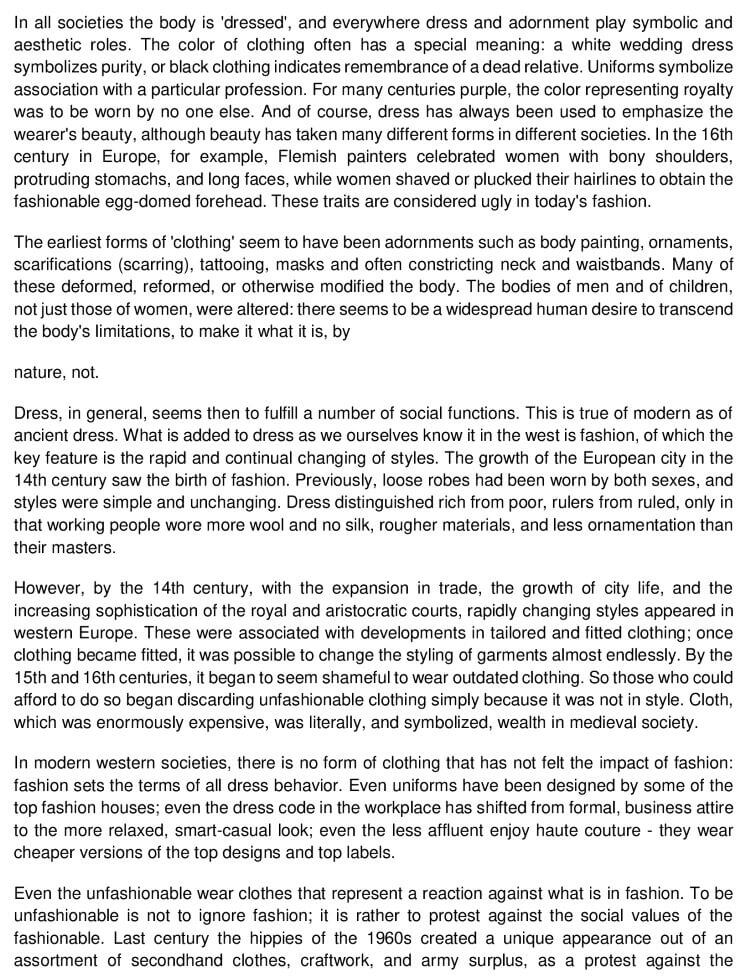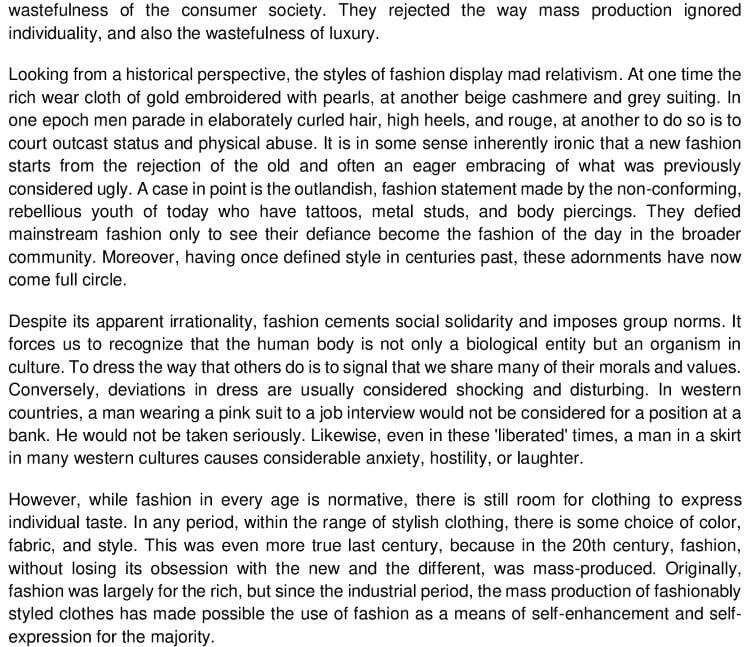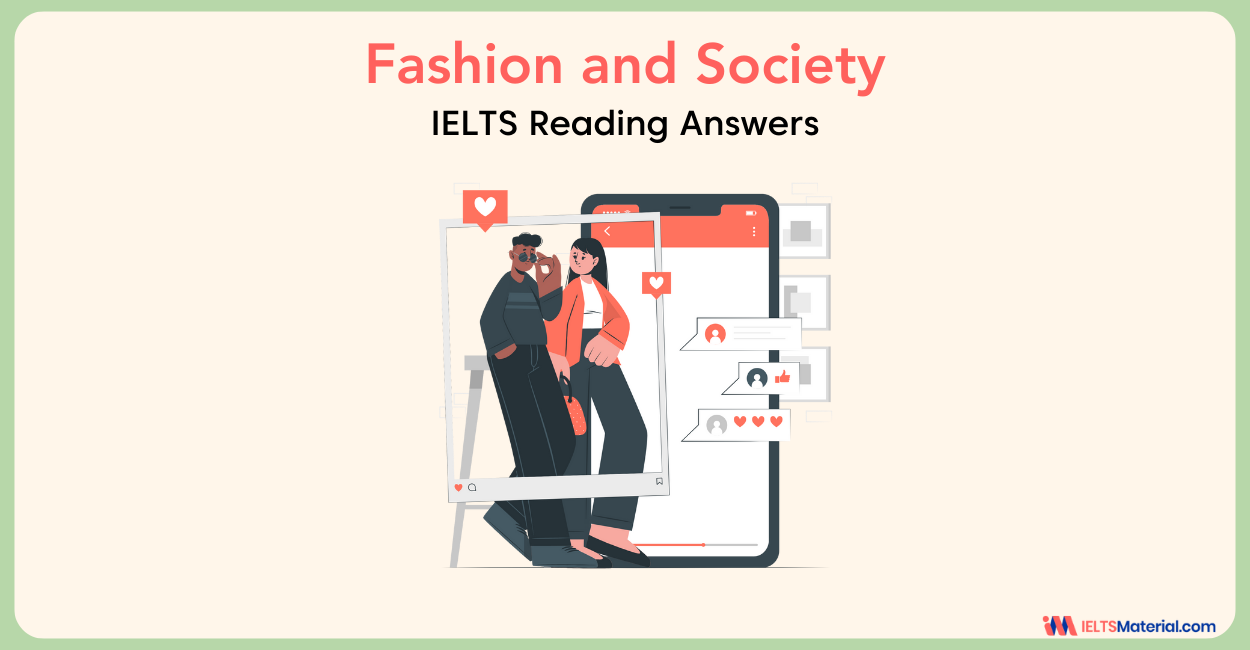Fashion and Society- IELTS Reading Answer
7 min read
Updated On
-
Copy link
Table of Contents

Limited-Time Offer : Access a FREE 10-Day IELTS Study Plan!
The Reading Module of the IELTS can be the top scoring category, with diligent practice. To achieve the best results in this section, you must understand how to approach and answer the different Question types in the Reading Module. By solving and reviewing Sample Reading Questions from past IELTS papers, you can ensure that your Reading skills are up to the mark.
Reading Passage
Fashion and Society


Questions 14-19
Complete the table below.
NO MORE THAN THREE WORDS AND/OR A NUMBER from the passage for each answer.
Write your answers in boxes 14-19 on your answer sheet.
| Period | Clothing Behaviour | Types of Clothing |
| earliest times | wearing 14______ | body painting, tattooing,
masks |
| Pre- 15___________ | simple, unchanging styles | 16________________ |
| 14th century | 17____________ | 18________________ |
| 15-16th centuries | 19______________ | Use of doth |
Questions 20-23
Complete each sentence with the appropriate ending,A-J, below.
Write the appropriate letter, A-J, in boxes 20-23 on your answer sheet.
20 The styling of apparel
21 Wearing outdated clothing
22 The impact of fashion
23 Mass production of fashionable clothing
- Allowed the less affluent to buy styled clothes.
- Was fell by top designers seeing fake, less expensive designer clothing on the market.
- Was made possible with the development of tailored and fitted clothing.
- Gave the individual a means of self-expression.
- Caused anxiety and hostility in western cultures.
- Was made possible with the increase in sophistication of the royal courts.
- Was seen as something shameful in earlier times.
- Had little effect on nonconforming youth.
- Distinguished the rich from the poor in earlier times.
- Was felt in the workforce with the change to informal wear.
Questions 24-26
Answer the questions below.
Choose NO MORE THAN ONE WORD from the passage for each answer. Write your answers in boxes 24-26 on your answer sheet.
A kind of adornment worn by defiant young people these days besides body
piercings and metal studs.
24 ________
What was a symbol of wealth in medieval times?25____________
Name ONE group of people who protested against the social values of the
fashionable. 26__________
Reading Answer
14 Answer: adornments
Question type: Table Completion
Answer location: Paragraph 2
Answer explanation: The initial lines of paragraph 2, states that the earliest forms of ‘clothing’ seem to have been adornments such as body painting, ornaments, scarifications (scarring), tattooing, masks and often constricting neck and waistbands. These lines suggest the clothing behavior of the earliest times, that is the people wore adornments with body painting, tattooing, and masks. Thus, the answer is adornments.
15 Answer: 14th-century
Question type: Table Completion
Answer location: Paragraph 3, line 2
Answer explanation: The 2nd line 3rd paragraph states that the growth of the European city in the 14th century saw the birth of fashion. Thus, it was during the 14th century that fashion took birth in European cities. Hence, the answer is the 14th century.
16 Answer: loose robes
Question type: Table Completion
Answer location: Paragraph 3, line 3
Answer explanation: Paragraph 3, line 3 illustrates the growth of European cities in the 14th century with the birth of fashion. However, before that, both genders wore loose roves and their styles were simple and unchanging. Thus, the answer is loose robes.
17 Answer: rapidly changing styles
Question type: Table Completion
Answer location: Paragraph 4
Answer explanation: Paragraph 4 states that in the 14th century, with the expansion in trade, the growth of city life, and the increasing sophistication of the royal and aristocratic courts, rapidly changing styles appeared in western Europe. These lines indicate that with the expansion in trade, growth of the city, and increasing royal and aristocratic courts, clothing behavior was rapidly changing. Thus, the answer is rapidly changing styles.
18 Answer: tailored and fitted/ tailored, fitted clothing
Question type: Table Completion
Answer location: Paragraph 4, line 2
Answer explanation: Paragraph 4 states that with the expansion in trade, growth of the city, and increasing royal and aristocratic courts, the clothing behavior was rapidly changing with different styles. In the 2nd kine, it is mentioned that these were associated with developments in tailored and fitted clothing; once clothing became fitted, it was possible to change the styling of garments almost endlessly. These lines indicate that the rapidly changing styles brought in the developments in tailored and fitted clothing. Hence, the answer is tailored and fitted clothing.
19 Answer: discarding unfashionable clothing
Question type: Table Completion
Answer location: Paragraph 4, line 4
Answer explanation: We understand from the 4th line of paragraph 4 that by the 15th and 16th centuries it began to seem shameful to wear outdated clothing. So those who could afford to do so began discarding unfashionable clothing simply because it was not in style. These lines indicate that those who could afford new clothing began to discard unfashionable clothing as it wasn’t in the trend. Thus, the answer is discarding unfashionable clothing.
20 Answer: C
Question type: Matching Sentence Endings
Answer location: Paragraph 4
Answer explanation: The 4th paragraph states that by the 14th century, with the expansion in trade, the growth of city life, and the increasing sophistication of the royal and aristocratic courts, rapidly changing styles appeared in western Europe. These were associated with developments in tailored and fitted clothing; once clothing became fitted, it was possible to change the styling of garments almost endlessly. These lines suggest that the styling of apparel was made possible with the development of tailored and fitted clothing. Thus, the answer is C.
21 Answer: G
Question type: Matching Sentence Endings
Answer location: Paragraph 4, line 4
Answer explanation: The 4th line of the 4th paragraph states that by the 15th and 16th centuries it began to seem shameful to wear outdated clothing. So those who could afford to do so began discarding unfashionable clothing simply because it was not in style. These lines reveal that wearing outdated clothing was seen as something shameful, and those who could afford new clothing began to discard unfashionable clothing as it wasn’t in the style. Thus, the answer is G.
22 Answer: J
Question type: Matching Sentence Endings
Answer location: Paragraph 5, line 3
Answer explanation: Paragraph 5 states the fact that no form of clothing has not felt the impact of fashion. The 3rd line of the 5th paragraph states that even uniforms have been designed by some of the top fashion houses; even the dress code in the workplace has shifted from formal, business attire to the more relaxed, smart-casual look; even the less affluent enjoy haute couture – they wear cheaper versions of the top designs and top labels. We can deduce from these lines that the impact of fashion was felt in the workplace with the change to informal wear.
23 Answer: D
Question type: Matching Sentence Endings
Answer location: Paragraph 7
Answer explanation: The last line of the 7th paragraph reveals that originally, fashion was largely for the rich, but since the industrial period the mass production of fashionably styled clothes has made possible the use of fashion as a means of self-enhancement and self-expression for the majority. These lines indicate that the mass production of fashionable clothing gave the individual a means of self-expression. Hence, the answer is D.
24 Answer: tattoos
Question type: Short Answer Question
Answer location: Paragraph 6, line 6
Answer explanation: The 6th line of the 6th paragraph states that a case in point is the outlandish, fashion statement made by the non-conforming, rebellious youth of today who have tattoos, metal studs, and body piercings. We can understand from these lines that a kind of adornment worn by defiant young people these days besides body piercing and metal studs. Thus, the answer is tattoos.
25 Answer: cloth
Question type: Short Answer Question
Answer location: Paragraph 3, last line
Answer explanation: The last line of the 3rd paragraph states that the enormously expensive Cloth was literally, and symbolized, wealth in medieval society. We can deduce from this that cloth was considered a symbol of wealth in medieval times. Hence, the answer is cloth.
26 Answer: hippies
Question type: Short Answer Question
Answer location: Paragraph 5, line 3
Answer explanation: In the 3rd line of paragraph 5, it is mentioned that last century, the hippies of the 1960s created a unique appearance out of an assortment of secondhand clothes, craftwork, and army surplus, as a protest against the wastefulness of the consumer society. These lines reveal that it was the hippies who protested against the social values of the fashion industry. Thus, the answer is Hippies.
Check More IELTS Reading Answers
Practice IELTS Reading based on question types

Start Preparing for IELTS: Get Your 10-Day Study Plan Today!
Recent Articles

Nehasri Ravishenbagam

Haniya Yashfeen

Haniya Yashfeen

Haniya Yashfeen




Post your Comments